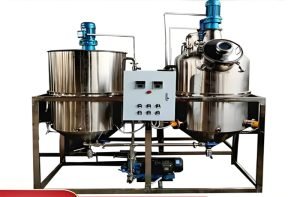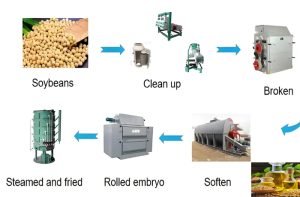Peanut oil press production line
Peanut oil is loved around the world for its wonderful nutty flavor and high-smoke point. This popularity makes it a fantastic business opportunity. Starting a peanut oil production line is a direct path to entering this profitable market. We are Fude Machinery. We are a specialized manufacturer of oil processing equipment. We design and build these lines every day for clients worldwide. We know exactly what it takes to turn simple peanuts into valuable, high-demand oil. This guide will show you every important step of the process.
Table of Contents
- What is a peanut oil press
- Peanut oil press treatment process
- Ratio of oil yield of oilseeds processed by screw press machine
- oil press machine: the difference between hot press and cold press
- Screw presses squeeze peanuts with residue?
- Oil presses for sale: Frequently Asked Questions
- Choosing the price of an oil press: summary and recommendations
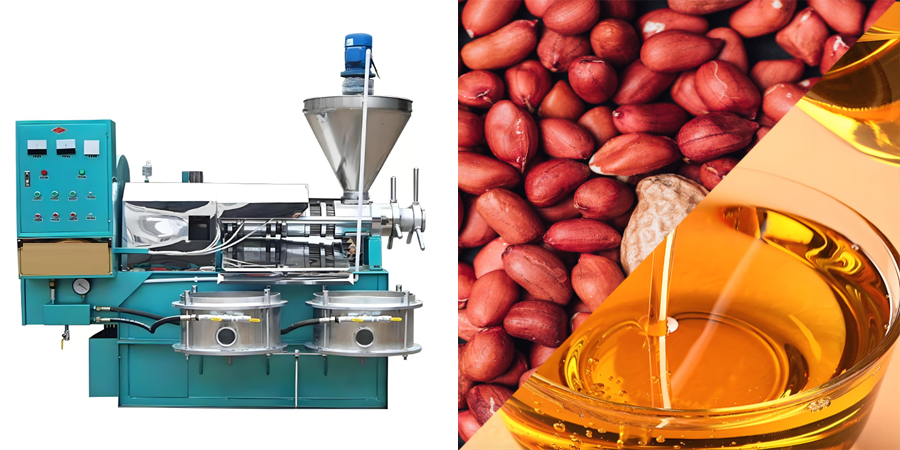
What is a peanut oil press
Peanut oil press production line is a fully automated oil and grease processing system integrating raw material pretreatment, pressing, filtration and refining, which transforms the peanut raw material into high-quality peanut oil conforming to the national standard by physical or chemical methods, and is widely used in small and medium-sized oil mills, medium-sized processing factories and large-scale oil and grease enterprises.
Peanut oil press treatment process
- Pre-treatment section
- Shelling and Peeling: Peanut shells are removed by shelling machine to improve subsequent processing capacity and oil yield.
- Cleaning and screening: Remove soil, gravel and metal impurities through vibrating screen, magnetic separator and stone remover to ensure the purity of raw materials.
- Crushing and rolling: the crusher crushes the peanuts into small pieces, and the embryo rolling machine further rolls the peanuts into thin embryo pieces (thickness ≤ 0.35mm), destroying the oil cell structure.
- Steam frying and tempering: Steam frying pan utilizes moist heat to denature proteins, reduce the viscosity of oil, and enhance the oil yield. Typical parameters are temperature 100-110℃, moisture 5%-7%.
- Pressing process: screw vs. hydraulic
- Screw Oil Press:
- Principle: The material embryo is pushed through the rotation of screw shaft, friction and heat are generated under high pressure, so that the oil is overflowed from the cells.
- Advantage: oil yield 42%-53% (peanut kernel), single machine daily capacity of up to 1 ton, suitable for peanuts, soybeans, rapeseed and other more than 20 kinds of oilseeds.
- Technology upgrade: Equipped with infrared temperature control system and high carbon steel press screw, the gap of oil line is reduced to 25 silk, which improves the pressing efficiency; the residue can be processed into high protein feed, realizing the recycling of resources.
- Hydraulic Oil Press:
- Application Scenario: Suitable for small scale production or high value-added oil processing, applying pressure through hydraulic system, stable oil yield but lower efficiency.
- Filtration and refining section
- Centrifugal oil filter: use centrifugal force to separate oil, residue and water, the filtered oil is clear and meets the standard of edible oil.
- Refining equipment (large production line configuration):
- Degumming: add electrolyte solution to remove phospholipids and other colloidal impurities.
- Deacidification: Neutralize the free fatty acid through alkaline refining or distillation to improve the stability of oil.
- Decolorization: adsorption of pigment by activated white clay to improve the color of oil.
- Deodorization: High temperature steam distillation removes odor components and produces first-grade or second-grade peanut oil.
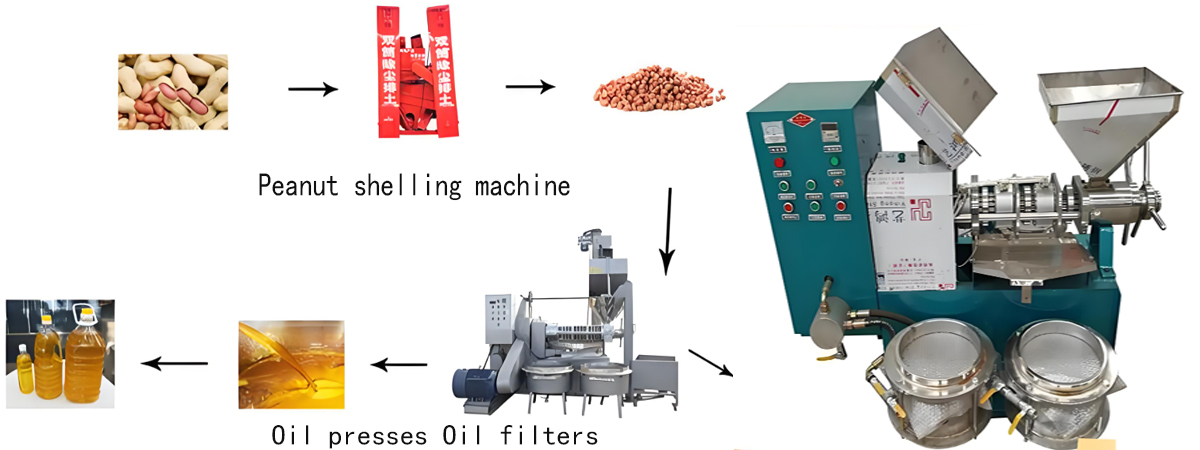
Ratio of oil yield of oilseeds processed by screw press machine
- Due to its high efficiency and multi-functionality, the oil press is able to press a wide range of oil crops and oil-bearing seeds, covering agricultural, food processing and industrial fields.
- Soybean: oil yield is about 12%-18%, and the crushed soybean cake can be used as feed or protein raw material.
- Canola (rapeseed): oil yield 30%-45%, is the main source of rapeseed oil.
- Peanut: oil yield 40%-50%, peanut oil has strong aroma and high market value.
- Cottonseed: oil yield 10%-20%, need to be pressed after detoxification treatment, cottonseed oil can be used for industry or food.
- Sunflower seed (sunflower): oil yield 25%-40%, sunflower oil is rich in unsaturated fatty acids.
- Sesame: oil yield 45%-55%, sesame oil (sesame oil) has a unique flavor and is suitable for cold pressing.
- Tea seeds: oil yield 20%-30%, tea oil is high-end cooking oil, storage resistance.
- Walnut kernel: oil yield 60%-70%, walnut oil is rich in nutrition, suitable for infants and children.
- Almond: oil yield 40%-50%, almond oil can be used in food or cosmetics.
- Flaxseed: oil yield 30%-40%, flaxseed oil is rich in α-linolenic acid, suitable for healthy cooking oil.
- Su seed (perilla seed): oil yield 35%-45%, Su seed oil has medicinal value.
- Safflower seed: oil yield 20%-30%, safflower seed oil is rich in vitamin E.
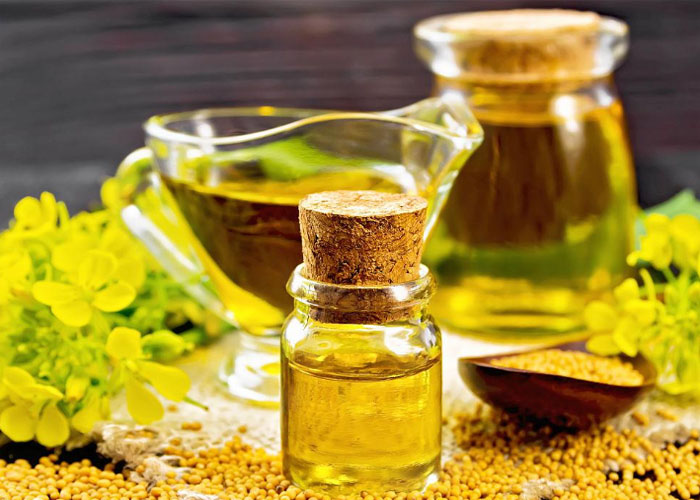

oil press machine: the difference between hot press and cold press
You should choose hot pressing for aromatic peanut oil and cold pressing for neutral oil.
After the kernels are roasted, they are sent to an oil press machine. The method you use here defines the type of oil you will produce. “Hot pressing” means pressing the peanuts right after they come out of the roaster. “Cold pressing” means pressing the raw, un-roasted peanuts.
For the vast majority of the peanut oil market, hot pressing is the standard. This is how you produce the fragrant, golden oil that is famous for cooking. The combination of roasting and pressing creates the best flavor and gives you the highest oil yield. Cold pressing is a much smaller niche.
It produces a very light-colored oil with a very mild, bland flavor. The yield is also lower. As a business, you need to decide which market you want to serve. At Fude Machinery, we build robust presses that can handle both methods, but we always advise our clients to understand this key difference.
| Feature | Hot Pressing (Roasted) | Cold Pressing (Raw) | What This Means for Your Business |
|---|---|---|---|
| Flavor & Aroma | Strong, Nutty, Aromatic | Mild, Bland, Neutral | Hot pressing creates the premium product most people want. |
| Oil Yield | Highest | Lower | You will get more oil and more profit per ton with hot pressing. |
| Market | Large, Mainstream Cooking Oil | Small, Niche Health Food | The market for aromatic peanut oil is much larger. |
| Process | Requires a Roasting Machine | Simpler, No Roasting | Hot pressing has an |
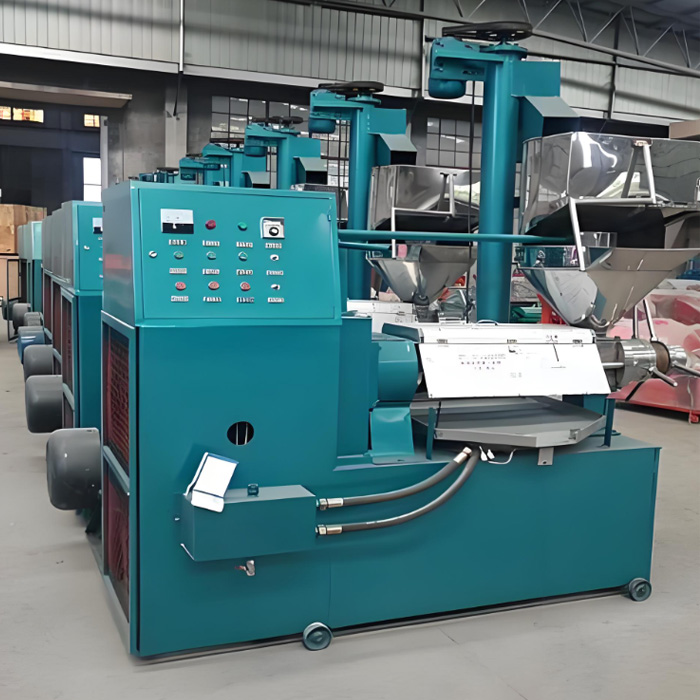
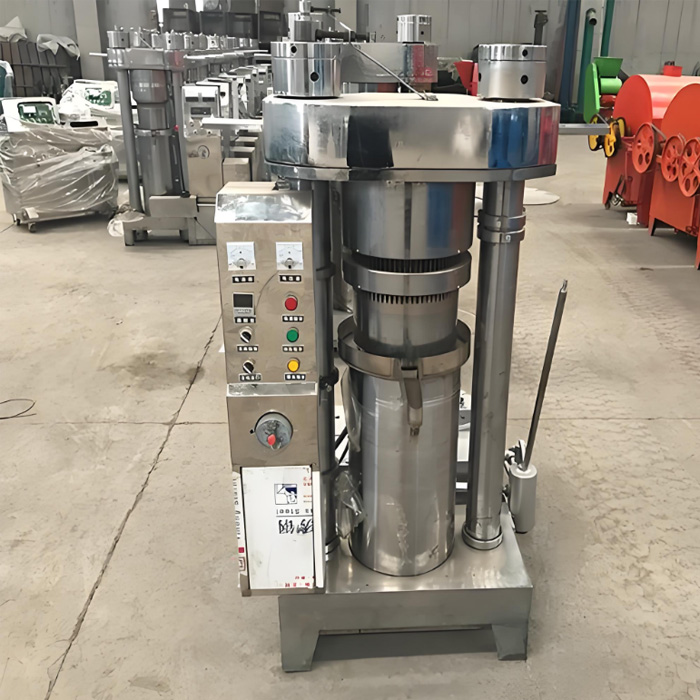
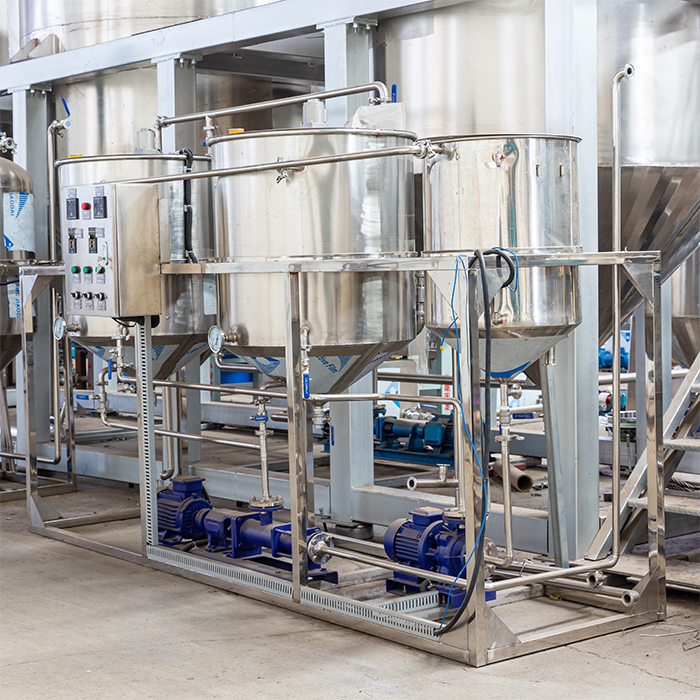
Screw presses squeeze peanuts with residue?
After pressing, you have two valuable products: crude oil and peanut cake. The process does not stop when the oil comes out of the press. The oil needs to be cleaned, and the solid material left behind is a very important source of secondary income. A well-designed peanut oil production line includes equipment to handle both of these valuable outputs.
Filtering the Crude Oil
The oil that comes directly from the press is called crude oil. It is cloudy because it contains very fine peanut particles. This oil must be cleaned before it can be sold. The simplest and most common method is filtration. The crude oil is pumped through oil filtration equipment. This can be a plate filter press or a centrifugal filter. The machine removes all the solid particles, leaving you with clear, bright, and beautiful peanut oil. For aromatic peanut oil made by hot pressing, this is often the final step before bottling.
Using the Peanut Cake
When you press peanuts, not all of the material turns into oil. The solid, compressed material that is left over is called peanut cake. This cake is not waste. It is extremely valuable. Peanut cake is very rich in protein. This makes it a perfect, high-quality ingredient for making animal feed for cattle, poultry, and fish. Many of our clients have told us that selling the peanut cake provides a very significant and stable second revenue stream. It can cover a large portion of your operating costs. This is a very important part of the business model.
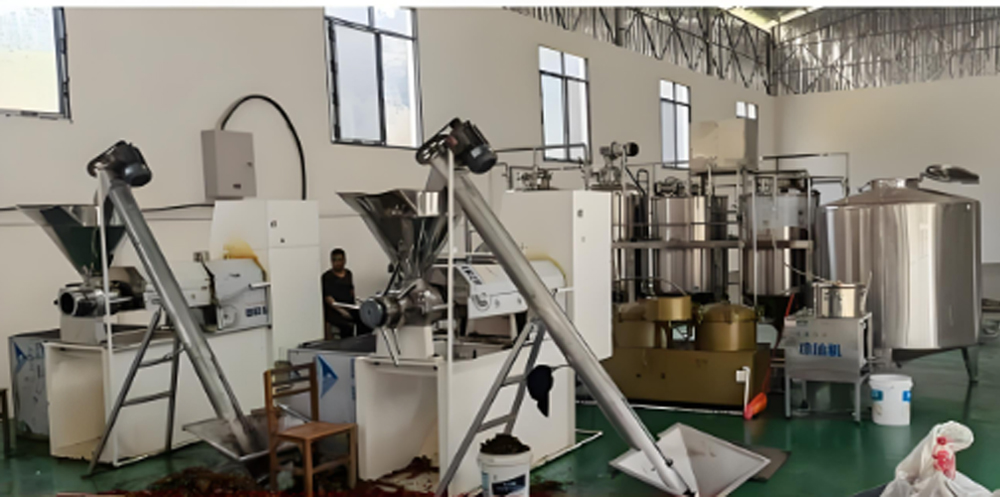
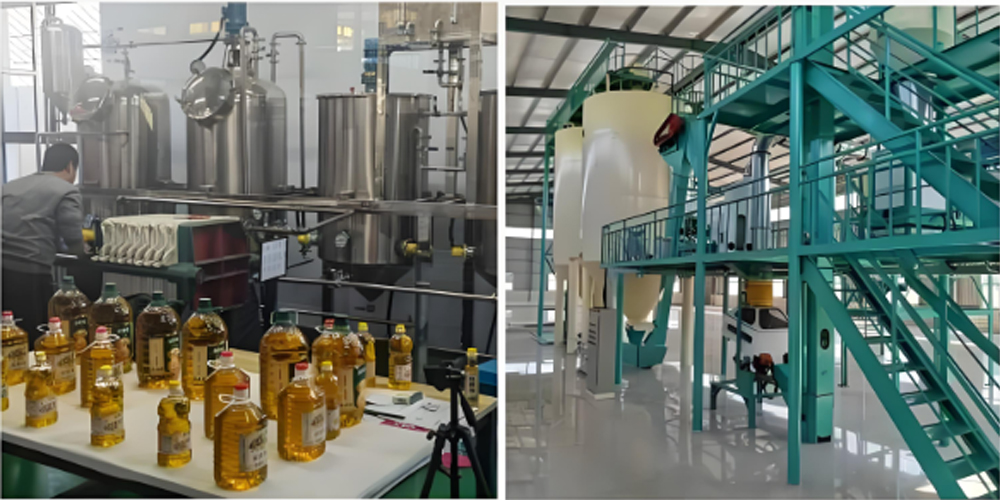
Oil presses for sale: Frequently Asked Questions
Question 1: How much oil can you get from peanuts?
Peanuts have a very high oil content, typically ranging from 45% to 52%. With a modern and complete peanut oil production line, especially one that includes proper roasting, you can achieve a very high oil extraction rate. This makes it one of the most profitable oilseeds to process.
Question 2: Do I have to roast the peanuts before pressing?
You do not have to, but for the most popular type of peanut oil, you should. Roasting (hot pressing) develops the strong, nutty aroma that consumers love. It also breaks down the oil cells, leading to a higher yield. Cold pressing is possible but produces a bland oil with a lower yield.
Question 3: What can I do with the peanut shells and cake?
Both are valuable. The peanut shells can be used as biofuel to power your plant’s boiler, reducing energy costs. The leftover peanut cake is a protein-rich resource perfect for making animal feed, creating a second income stream for your business.
Choosing the price of an oil press: summary and recommendations
Starting a successful peanut oil production line is a clear and achievable goal. Your success will depend on understanding and mastering the key steps. You must invest in proper pre-treatment including shelling and especially roasting. You need to make a strategic choice between hot pressing for flavor and cold pressing for neutrality. Finally, you must have a plan to filter your oil and sell the valuable peanut cake.
By partnering with an experienced, factory-direct manufacturer like Fude Machinery, you get more than just machines. You get a complete, integrated solution designed for profitability. We are here to guide you through every decision, ensuring your venture is successful.

Related recommendations
-
edible oil refining equipment
1199A refining machine is a mechanical device that removes impurities from raw materials through physical or chemical methods, thereby enhancing the purity and quality of the product. It is widely used in various industries such as edible oil, rub...
View details -
Soybean oil production line
215Soybean oil is one of the most widely used vegetable oils in the world. For business owners, this huge demand means a fantastic opportunity for profit. But starting a soybean oil production line can feel like a huge challenge. There are many step...
View details
 Oil Press Equipment and Oil Refining Machinery for Sale – Start Your Oil Press Business
Oil Press Equipment and Oil Refining Machinery for Sale – Start Your Oil Press Business
